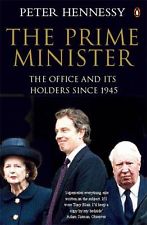Our book group choice for January 2008 is The Prime Minister: The Office and Its Holders Since 1945 by Peter Hennessy. “H. H. Asquith, Prime Minister during the first World War, famously said that the job of Prime Minister “is what its holder chooses and is able to make of it.”
The Prime Minister: The Office and Its Holders Since 1945 is a comprehensive and authoritative study of the British premiership since the end of World War II. Written by Peter Hennessy, a leading expert on British government, the book examines the formal powers of the Prime Minister and how each incumbent has made the job their own.
Hennessy begins by providing an overview of the history of the British premiership, from its origins in the 17th century to the present day. He then discusses the formal powers of the Prime Minister, which include the ability to appoint and dismiss ministers, dissolve Parliament, and declare war. However, Hennessy argues that the real power of the Prime Minister comes from their ability to control the political agenda and to set the tone for government policy.
The bulk of the book is devoted to a detailed analysis of the 11 postwar prime ministers, from Clement Attlee to Tony Blair. Hennessy provides a biographical sketch of each prime minister, and then discusses their style of leadership, their key achievements, and their legacy. He also examines the changing power structures within the British government during this period, and the impact of these changes on the office of the Prime Minister.
One of the most striking features of the book is Hennessy’s use of recently declassified archival material. This material provides a fascinating glimpse into the inner workings of government, and it allows Hennessy to reconstruct the precise attitudes of each prime minister towards key issues such as nuclear weapons policy, the planning and waging of war, and foreign crises from Suez to the Falklands.
Hennessy concludes the book with a controversial assessment of the relative performance of each postwar prime minister. He argues that the most successful prime ministers have been those who have been able to combine strong leadership with a willingness to listen to advice. He also argues that the premiership is becoming increasingly demanding, and that future prime ministers will need to be even more skillful and adaptable than their predecessors.
Discussion Questions
- What are the key powers and responsibilities of the Prime Minister?
- How has the role of the Prime Minister changed since 1945?
- What are the different styles of leadership that Prime Ministers have adopted?
- How important is the relationship between the Prime Minister and the Cabinet?
- What role does the Prime Minister play in the making of foreign policy?
- How has the Prime Minister’s relationship with the media changed over time?
- How has the Prime Minister’s role in the House of Commons changed over time?
- What are the challenges and opportunities facing the Prime Minister in the 21st century?
- Who are the most successful Prime Ministers since 1945?
- Who are the most controversial Prime Ministers since 1945?
- What are the key lessons that can be learned from the history of the Prime Ministership?
- What are the implications of the book for the future of British politics?
- How does the British Prime Ministership compare to the role of the President in other countries?
- What are the strengths and weaknesses of the British system of Prime Ministerial government?
- What reforms would you recommend to improve the role of the Prime Minister?
- How do the Prime Ministers since Tony Blair fit into the thesis of the book?
- Would you recommend this book to anyone? Why or why not?

